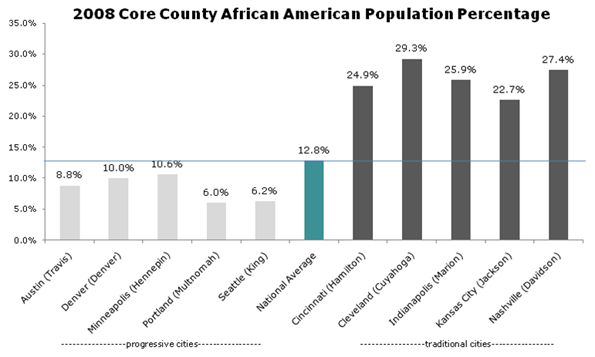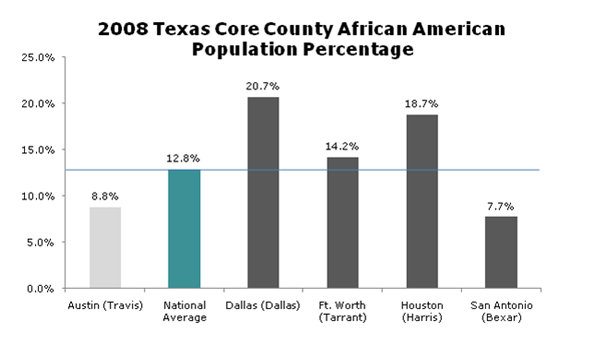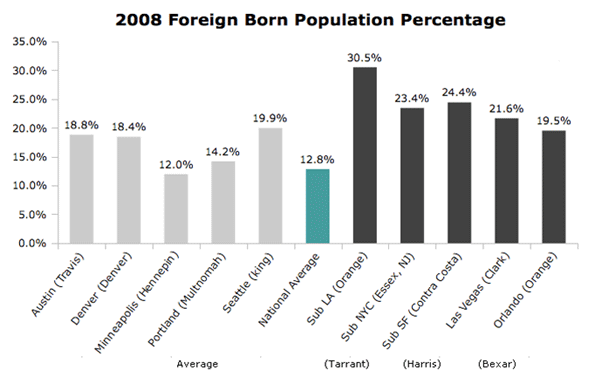
Among the media, academia and within planning circles, there’s a generally standing answer to the question of what cities are the best, the most progressive and best role models for small and mid-sized cities. The standard list includes Portland, Seattle, Austin, Minneapolis, and Denver. In particular, Portland is held up as a paradigm, with its urban growth boundary, extensive transit system, excellent cycling culture, and a pro-density policy. These cities are frequently contrasted with those of the Rust Belt and South, which are found wanting, often even by locals, as “cool” urban places.
But look closely at these exemplars and a curious fact emerges. If you take away the dominant Tier One cities like New York, Chicago and Los Angeles you will find that the “progressive” cities aren’t red or blue, but another color entirely: white.
In fact, not one of these “progressive” cities even reaches the national average for African American percentage population in its core county. Perhaps not progressiveness but whiteness is the defining characteristic of the group.

The progressive paragon of Portland is the whitest on the list, with an African American population less than half the national average. It is America's ultimate White City. The contrast with other, supposedly less advanced cities is stark.
It is not just a regional thing, either. Even look just within the state of Texas, where Austin is held up as a bastion of right thinking urbanism next to sprawlvilles like Dallas-Ft. Worth and Houston.

Again, we see that Austin is far whiter than either Dallas-Ft. Worth or Houston.
This raises troubling questions about these cities. Why is it that progressivism in smaller metros is so often associated with low numbers of African Americans? Can you have a progressive city properly so-called with only a disproportionate handful of African Americans in it? In addition, why has no one called these cities on it?
As the college educated flock to these progressive El Dorados, many factors are cited as reasons: transit systems, density, bike lanes, walkable communities, robust art and cultural scenes. But another way to look at it is simply as White Flight writ large. Why move to the suburbs of your stodgy Midwest city to escape African Americans and get criticized for it when you can move to Portland and actually be praised as progressive, urban and hip? Many of the policies of Portland are not that dissimilar from those of upscale suburbs in their effects. Urban growth boundaries and other mechanisms raise land prices and render housing less affordable exactly the same as large lot zoning and building codes that mandate brick and other expensive materials do. They both contribute to reducing housing affordability for historically disadvantaged communities. Just like the most exclusive suburbs.
This lack of racial diversity helps explain why urban boosters focus increasingly on international immigration as a diversity measure. Minneapolis, Portland and Austin do have more foreign born than African Americans, and do better than Rust Belt cities on that metric, but that's a low hurdle to jump. They lack the diversity of a Miami, Houston, Los Angeles or a host of other unheralded towns from the Texas border to Las Vegas and Orlando. They even have far fewer foreign born residents than many suburban counties of America's major cities.

The relative lack of diversity in places like Portland raises some tough questions the perennially PC urban boosters might not want to answer. For example, how can a city define itself as diverse or progressive while lacking in African Americans, the traditional sine qua non of diversity, and often in immigrants as well?
Imagine a large corporation with a workforce whose African American percentage far lagged its industry peers, sans any apparent concern, and without a credible action plan to remediate it. Would such a corporation be viewed as a progressive firm and employer? The answer is obvious. Yet the same situation in major cities yields a different answer. Curious.
In fact, lack of ethnic diversity may have much to do with what allows these places to be “progressive”. It's easy to have Scandinavian policies if you have Scandinavian demographics. Minneapolis-St. Paul, of course, is notable in its Scandinavian heritage; Seattle and Portland received much of their initial migrants from the northern tier of America, which has always been heavily Germanic and Scandinavian.
In comparison to the great cities of the Rust Belt, the Northeast, California and Texas, these cities have relatively homogenous populations. Lack of diversity in culture makes it far easier to implement “progressive” policies that cater to populations with similar values; much the same can be seen in such celebrated urban model cultures in the Netherlands and Scandinavia. Their relative wealth also leads to a natural adoption of the default strategy of the upscale suburb: the nicest stuff for the people with the most money. It is much more difficult when you have more racially and economically diverse populations with different needs, interests, and desires to reconcile.
In contrast, the starker part of racial history in America has been one of the defining elements of the history of the cities of the Northeast, Midwest, and South. Slavery and Jim Crow led to the Great Migration to the industrial North, which broke the old ethnic machine urban consensus there. Civil rights struggles, fair housing, affirmative action, school integration and busing, riots, red lining, block busting, public housing, the emergence of black political leaders – especially mayors – prompted white flight and the associated disinvestment, leading to the decline of urban schools and neighborhoods.
There's a long, depressing history here.
In Texas, California, and south Florida a somewhat similar, if less stark, pattern has occurred with largely Latino immigration. This can be seen in the evolution of Miami, Los Angeles, and increasingly Houston, San Antonio and Dallas. Just like African-Americans, Latino immigrants also are disproportionately poor and often have different site priorities and sensibilities than upscale whites.
This may explain why most of the smaller cities of the Midwest and South have not proven amenable to replicating the policies of Portland. Most Midwest advocates of, for example, rail transit, have tried to simply transplant the Portland solution to their city without thinking about the local context in terms of system goals and design, and how to sell it. Civic leaders in city after city duly make their pilgrimage to Denver or Portland to check out shiny new transit systems, but the resulting videos of smiling yuppies and happy hipsters are not likely to impress anyone over at the local NAACP or in the barrios.
We are seeing this script played out in Cincinnati presently, where an odd coalition of African Americans and anti-tax Republicans has formed to try to stop a streetcar system. Streetcar advocates imported Portland's solution and arguments to Cincinnati without thinking hard enough to make the case for how it would benefit the whole community.
That's not to let these other cities off the hook. Most of them have let their urban cores decay. Almost without exception, they have done nothing to engage with their African American populations. If people really believe what they say about diversity being a source of strength, why not act like it? I believe that cities that start taking their African American and other minority communities seriously, seeing them as a pillar of civic growth, will reap big dividends and distinguish themselves in the marketplace.
This trail has been blazed not by the “progressive” paragons but by places like Atlanta, Dallas and Houston. Atlanta, long known as one of America's premier African American cities, has boomed to become the capital of the New South. It should come as no surprise that good for African Americans has meant good for whites too. Similarly, Houston took in tens of thousands of mostly poor and overwhelmingly African American refugees from Hurricane Katrina. Houston, a booming metro and emerging world city, rolled out the welcome mat for them – and for Latinos, Asians and other newcomers. They see these people as possessing talent worth having.
This history and resulting political dynamic could not be more different from what happened in Portland and its “progressive” brethren. These cities have never been black, and may never be predominately Latino. Perhaps they cannot be blamed for this but they certainly should not be self-congratulatory about it or feel superior about the urban policies a lack of diversity has enabled.
Aaron M. Renn is an independent writer on urban affairs based in the Midwest. His writings appear at The Urbanophile.













"Denver" - Five Counties
This clarification is correct. As is often the case, confusion about the "city" as compared to the "metro area" is at play. If the author suggests that the percentages are for the metro area, then diversity is stated at a lower rate than the city itself. So which is it?
What's often meant by "Denver" is the five county metro area, which is far beyond the city/county of Denver.
The author's misstatement of the facts reveals a lack of understanding of this subject.
What about black as proxy for minority?
Thanks for your reply. All comparisons aren't perfect, we know this; the question is which is best. And not for all general comparisons, but this one. Using county data specifically dilutes the thing you are measuring, minority population, much more than city data.
You didn't address my larger problem, you cited data on blacks, and talked about how white a county was.
You're welcome.
http://norwegianshooter.blogspot.com
I would encourage you to
I would encourage you to pull the African American population percentages for the core cities as well if you think that is a better comparison. I would be interested in seeing the results. If I might speculate, the % Black percentage in Minneapolis would indeed be higher, but other cities would might go up by even more. I might suggest checking Detroit, Milwaukee, St. Louis, Cleveland, and Cincinnati as your benchmarks.
Also, it is true that Not Black != White, so if you'd prefer, we could change the emphasis to the Not Black City. My argument from the piece was precisely that these cities like to use an alternative measure of diversity to divert attention from the fact that they have low African American populations. Much like a company that hired very few blacks touting all the Asians they have on the payroll.
Minneapolis city counts
You are correct, the city of Minneapolis was about 18% African-American (as of the 2000 census), well above the national average. Certainly, if you are talking about cities that are beacons of progressivism (or liberalism), there is a huge difference between the relative liberalism of the city of Minneapolis and that of the suburban communities in Hennepin County. Michelle Bachman's district, for example, comprises an area that is (largely) suburban Minneapolis, albeit not within Hennepin County.
It seems to me that these perceptions about these cities are usually about the cities themselves, not the surrounding suburbs, and that the city should be used as the unit for comparison.
(And, of course, throwing out the Tier 1 cities, such as New York, Chicago and Los Angeles, seems to vitiate any validity of the conclusions here.)
I have to disagree on the
I have to disagree on the use of county data as a proxy for a city. City has two meanings — one is political, referring to a municipal government. Another has to do with urban form. The city is a denser place with a more urban feel than the surrounding suburbs and countryside. The demographics are often radically different between the city and the suburbs. Both of these meanings of city, crucial in where people choose to live, is lost in your use of county data.
Cities and suburbs are completely different animals. People choose to live in one or the other as much as they choose to live in one region or another.
When people refer to a city like Austin as "progressive," they are referring more to the city itself than the suburbs.
You need to rethink your bias for using county data as a proxy for cities.
just about any unit you choose will have problems
Because the whole process of urbanization in this country has little correlation to our political subdivisions, there will be problems with just about any unit you choose for comparison.
For instance, Aaron choosing Jackson County as a proxy for Kansas City, Mo., is arguably better than using the City of Kansas City itself. Even though Jackson County also encompasses Independence (the county seat), Grandview, Raytown, Blue Springs, and a passel of other suburbs, it also includes all of the pre-World War II urban area, the most densely populated part of the city and (my estimate) home to nearly 3/4 of the city's population of about 450,000 and about 40 percent of the county's population of around 700,000. Meanwhile, the city covers some 320-plus square miles in parts of four counties, and much of the outlying areas of the city are still planted in corn and soybeans, especially near the airport. Meanwhile, Jackson County may well be more thoroughly urbanized than the city.
Either way, you get distortion.
Sandy Smith, Exile on Market Street, Philadelphia
Ever notice how planners wave Jane Jacobs like a talisman as they go about ignoring her main points?
Black and White Article
Good point, Shooter. Asian populations are much higher in the Northwest. Seattle (King County) alone has a good 13% Asian population. Seattle's white population is actually about the same as some of the "traditional cities" listed, at just about 70% white vs. minority populations.
To comment on Portland, it has implemented "Portland-style" transportation projects in historically and traditionally minority neighborhoods (NE Portland and Interstate MAX system). These neighborhoods are about 50% white, and have reasonably large Africa-American populations to the tune of 35% in some areas according to Census data.
I am not really drawing the connections of what this article is about. I think it needs to be more explicit. To say that Portland style planning doesn't benefit minorities is akin to saying that past planning methods of the Rust Belt cities have benefited minority populations. Both aren't perfect, but let's at least bring some solutions or ideas to the table if you disagree with something.
Another take on the White City
Aaron,
I've lived in Portland for 5 years now. I grew up in the Chicago area, and have lived in several other places with much larger African-American populations than Portland. Your article touches on an interesting and important subject, and I don't have time to do it justice right now, but want to take issue with one of your arguments.
If I understand you correctly, you are suggesting that the main reason that Portland-style transportation policies don't transfer to rust-belt cities is because they don't address the needs of minority populations in those places. That may or may not be true, but I think the larger issue is that many whites in cities with high minority populations are unwilling to fund public transportation and other public goods, because they see it as taking money away from "us" and giving it to "them" (poor minorities. In most of those areas, middle-class whites have long since fled to the suburbs, and don't see public transportation as benefiting them. I have a hard time believing that minority populations in most Midwestern cities wouldn't benefit from and want better public transportation - in fact, a significant challenge is that in many cities, jobs have fled to the suburbs along with middle-class whites and minority residents can't access them because they have no way to get to them.
That said, it stands to reason that what works in Portland might not work in Cincinnati and that Portland's policies can't just be transferred wholesale to another city.
I would agree that is
I would agree that is another potential part of the dynamic that is different in those cities.
Toronto
I kept thinking this too as I was reading your article... it's really not about `homogeneous consensus' or whatever. Then you said ``black people are the sine qua non of diversity' or something and I couldn't believe you said that... Bedford Stuyvesant is not diverse. Inner city Detroit is not diverse. Only black people live there. That's not diversity.
The best example of my point is Toronto.
Toronto could well be the paragon of the North American ``progressive city''. Transit ridership is way higher than in Portland, it's dense, bike friendly, yadayada. It's also 50% foreign born. 50%! That's diversity. It has dozens of ethnicities, not just two. What it doesn't have are racialized social divisions. That's the problem with American cities, and you seemed to completely miss that even as you were talking about it.